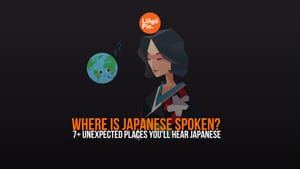This article is part 3 of a 3 part series. The first part focuses on how to learn hiragana, the second katakana, and the third kanji.
The good news? This is an easy and simple guide on how to learn kanji. The bad news? Japanese kanji is anything but easy and simple to learn.
With well over 50,000 characters, Japanese students spend all of their time in elementary and high school learning how to read and write kanji.
However, difficult does not mean impossible! And, let's face it, nothing worth doing is easy.
See also: Best Way to Learn Japanese
Disclaimer: you will need a working knowledge of at least hiragana in order to fully understand kanji.
In this post, we will cover the history of kanji, its relationship to other Japanese scripts, and break down digestible learning strategies to study kanji. We will also take a look at how to incorporate different resources into your learning methodology, so you won't have to depend on Japanese textbooks or rote memorization.
With a little time and dedication, you'll be well on your way to learning kanji and making strides in studying Japanese.
Ready? 行きましょう!

What is Kanji? A Quick Background to the Japanese Language
Kanji was introduced to Japan in the 5th century from China and played a significant role in shaping Japanese culture, language, history, and literature. In fact, the name kanji, or 漢字, literally means "Chinese characters."
Chinese characters originally arrived in Japan on letters, official seals, swords, coins, and other artifacts imported from China. However, the Japanese people of that era probably had little or no comprehension of the script.
Eventually, Japanese kanji developed from this to write texts in vernacular Japanese. This resulted in the creation of the kana: hiragana and katakana.
Unlike the phonetic scripts of hiragana and katakana, kanji is logographic or ideographic. This means that each kanji represents a word, thing, or idea.
Some of the same characters are used in Japanese and Chinese and have similar pronunciations and meanings. However, other kanji have qualities that are unique to one language or the other.
Today, kanji plays an integral in the Japanese language and is a necessary part of everyday life.

Differences Between Kanji and Hiragana
As you may already know, kanji, hiragana, and katakana all play very different parts in the written Japanese language.
In order to start learning kanji, Japanese learners must have a solid grasp of hiragana.
While hiragana and kanji are both used to write native Japanese words, the usage behind each script is different.
Hiragana is used to depict the pronunciation of words, while kanji is used to convey the meaning of a word.
For example, take the kanji characters 花 and 鼻.
Both of these are pronounced はな (hana). However, if you were to write this in only hiragana, the reader would not know the meaning you were trying to convey.
Although the pronunciation is the same, each individual kanji holds its own meaning.
The kanji 花 means "flower,"
while the kanji 鼻 means "nose."
How to Start Learning Kanji
So, how does one go about beginning to learn such a difficult writing system?
Before you feel overwhelmed, just know that learning kanji is absolutely achievable when using an effective study method and setting learning goals.
As with hiragana and katakana, kanji can be broken down into basic building blocks.
Learn Kanji Reading: Radicals
Complex kanji can be broken down into smaller, simpler characters called radicals. There are 214 of them, and a great way to learn kanji is to learn radicals first. Radicals are combined with other kanji to form new characters.
If you learn all the radicals, you can understand complex kanji meanings, and vocabulary words, as well as be able to tell the difference between similar kanji.
Let's take a look at an example:
The kanji for the Japanese word meaning "water," or mizu (みず), is the character 水.
When 水 is reduced to a radical, it looks like 氵. So, when you see the radical 氵, you will know that kanji's meaning will have something to do with water.
If you see 氵 combined with 立, meaning "to stand," you will get a new kanji: 泣. meaning to cry. Think of it like this: if you are saying goodbye to a loved one, you are standing and making water with your eyes and therefore crying.
Using a mnemonic story such as this is an effective way to help remember kanji characters.
Furthermore, you can think of radicals as affixes used in English. For example, we know that "re-" means "again," and "in-" or "un-" creates the negative meaning of a word.
Here are a few more kanji that use the water radical:
- 汁 is the kanji meaning "soup, juice, or broth"
- 汗 is the kanji meaning "sweat, or to perspire"
- 海 is the kanji meaning "ocean"
- 酒 is the kanji meaning "alcohol"
Kanji Learning: Image Association
Another way to learn kanji is to associate a kanji with an image. Kanji are ideographic; they sometimes look like a simplified image of the idea or vocabulary word they are trying to convey.
For example:
- The kanji 人 means person. Think of a person standing with their hands at their side.
- The kanji 木 means tree. Very simply, it looks like a tree standing alone.
- The kanji 川 means river. Imagine each outside line is a river bank, and the line in the middle is a flowing stream.
Once you start to get into the habit of image association, reading Japanese will become much easier.
Learn Kanji Reading: Pronunciation
Taking the time to learn kanji pronunciation correctly may be one of the most difficult parts of learning Japanese.
Kanji characters can have two or more pronunciations depending on their context. Sometimes, kanji characters can stand alone to convey certain words; sometimes, they are combined with other kanji to create new words; and other times, they are combined with hiragana as parts of words such as verb or adjective stems.
The easiest way to start learning how to pronounce kanji is by learning their onyomi and kunyomi pronunciation.

Onyomi vs kunyomi
So what are onyomi and kunyomi?
Both of these refer to how you can read a particular kanji. In other words, the onyomi pronunciation is derived from Chinese, while kunyomi is the Japanese pronunciation of a character.
Let's look at an example:
Remember the kanji for tree?
The Japanese kanji 木 is pronounced "ki" (き), and means "tree" or "trees." This is the kunyomi pronunciation of 木.
Conversely, the onyomi reading of 木 is "moku" (もく), as seen in the word 木曜日, which is pronounced "mokuyoubi" (もくようび) and means Thursday.
Paying attention to the placement of a kanji is key to reading comprehension. Standing alone, 木 means "tree," and when placed next to two other specific kanji in 木曜日, it means Thursday.
A special note: kanji don't always have both onyomi and kunyomi readings — some have only one or the other.
Unfortunately, there are no hard and fast rules to learning how to read kanji. However, you will start learning kanji with more exposure, and a great way to start is by focusing on the jouyou kanji.
Jouyou Kanji
The jouyou kanji, or 常用漢字, meaning "commonly used Chinese characters," is a set of around 2,000 kanji characters that Japanese students learn from elementary to high school.
They are the most common Japanese kanji, and you will be able to understand at least 80% of the Japanese language if you learn all the readings of these characters.
Again, there are over 50,000 kanji and even native speakers have trouble remembering all of these characters. However, You will be able to read Japanese (in most cases) if you focus on the jouyou kanji.
Furthermore, you might want to supplement the jouyou kanji by studying Japanese words that are important to your life and interests.
There is no easy way around it: the rote memorization of vocabulary words, spaced repetition, and drilling is the only way to learn new words and new kanji.
However, a great way to ease the memorization process is to learn kanji through writing practice.
How to Write Kanji: Practice Tips
Writing and learning the correct stroke order of each character is essential for Japanese learners to learn kanji.
Unlike hiragana and katakana, there is no definitive and all-encompassing 'kanji chart.' Instead, focus on creating your own kanji learning materials for vocabulary and practical use.
Practice Stroke Order
Stroke order, stroke order, stroke order!
We can't emphasize stroke order enough.
Writing kanji, like writing hiragana and katakana, is an elegant, delicate process, and is considered an art form in Japan. Writing practice is crucial, and one must correctly practice stroke order.
Kanji depends upon the correct execution of individual strokes; there are many similar kanji characters and one mistake could convey the wrong meaning.
Additionally, writing kanji is a great way to remember words and learn vocabulary.

Find a Japanese Pen Pal
Perhaps the best thing you could do for learning kanji is to find a native speaker with whom you can exchange writing emails, texts, or postcards.
You could find a pen pal by posting on a language forum or on Reddit. Becoming pen pals with a native speaker is a hands-on method to learn Japanese.
Not only will you be able to practice your writing and reading, but you will be able to connect with real Japanese people so you can ask questions about a particular kanji's meaning, or anything else related to learning Japanese.
You could learn a new word here or there which would reduce the time compared to learning kanji without a pen pal.
Plus, you'll have a friend whenever you decide to visit Japan!
Learning Kanji Through Video
Who says studying has to be boring?
Another great way to learn kanji is to start watching anime, movies, and TV shows with subtitles. So many people have learned kanji this way!
By engaging with Japanese media, you will be able to hear how Japanese is naturally spoken, and pick up on social cues and colloquialisms you might not find in a typical "kanji book."
And if you're going to binge on television for a few hours, you might as well use that time to study kanji and teach yourself some new vocabulary words
A website like Lingopie provides a wide array of Japanese resources to help you learn Japanese kanji while watching Japanese movies and TV shows.
With Lingopie, you can access many popular Japanese anime, movies, and TV shows you might find on Netflix.
However, on top of this, Lingopie also provides online tools like interactive subtitles and flashcards to more conveniently and easily learn kanji.
For access to a diverse selection of great Japanese TV shows and films, sign up for Lingopie. This streaming service offers quality Japanese shows and films that are optimal to help you read Japanese and better learn kanji.

Summing Up: Learning Kanji
By now, you should be familiar with what it takes to start learning kanji!
We have covered a brief history of kanji, its roots in Chinese, and how important it is for attaining Japanese literacy.
You should be able to understand the relationship kanji has to hiragana and katakana, and the way the three scripts are used in writing Japanese.
The time it takes to learn kanji depends solely on your dedication, effort, and planning!
Depending on how many kanji or vocabulary words you can learn in one week, you may be able to tackle most of the joyou kanji in just over a year!
Supplement your studies by picking up a kanji book or creating your own kanji learning materials, and pay attention to stroke order when writing kanji! Practice writing frequently, using flashcards or notebooks.
Remember that kanji can have multiple meanings depending on the context in which you are reading them!
And remember to have fun! Be sure to use Lingopie's resources to help with reading kanji, learning vocabulary words, and understanding the characters' different meanings through movies and TV shows.
頑張ってね!!





![10 Best TV Series on Netflix to Learn English [For Beginners]](/blog/content/images/size/w1200/2022/12/10-Best-TV-Shows-on-Netflix-to-Learn-English.png)


![How To Use Mo (も) Particle In Japanese Grammar [Guide]](/blog/content/images/size/w300/2025/06/How-To-Use-Mo-----Particle-In-Japanese-Grammar.jpg)
